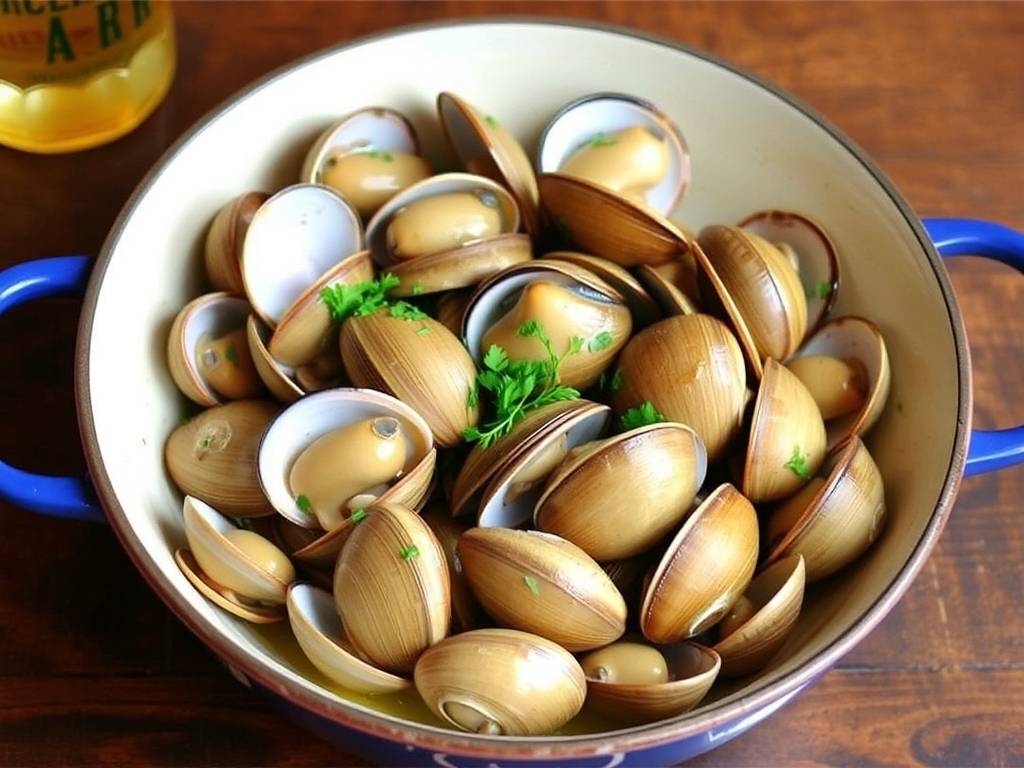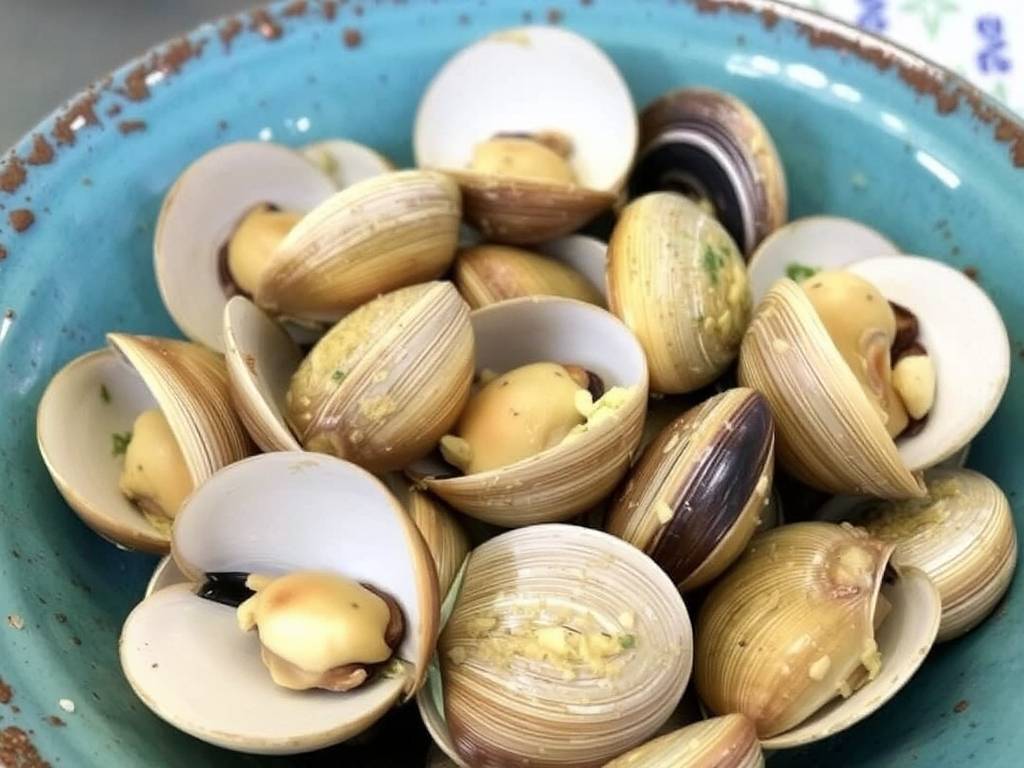Steamed Clams in a Garlic Butter and Beer Broth: A Coastal Feast in a Bowl
There is a particular, almost primal joy that comes from eating steamed clams. It is a dish that demands engagement, inviting you to use your hands, to break bread, and to savor every last drop of the aromatic broth. Among the myriad ways to prepare these bivalve mollusks, few methods are as universally satisfying as steaming them in a fragrant bath of garlic butter and beer. This recipe is more than just a set of instructions; it is a celebration of simplicity, where a handful of humble ingredients are transformed into a spectacular, soul-warming meal.
The beauty of this dish lies in its deceptive elegance. It feels luxurious, yet it is remarkably straightforward to prepare, requiring minimal active cooking time and a forgiving nature that welcomes improvisation. The combination of rich, nutty butter, pungent garlic, and the complex, malty notes of beer creates a broth that is so delicious, you’ll find yourself searching for a crusty loaf of bread to sop up every last bit. It’s the perfect centerpiece for a casual summer gathering on the patio or a comforting dinner on a chilly evening, a true testament to the magic that happens when land and sea meet in a single pot.

The Foundation: Selecting Your Clams
The journey to a perfect pot of clams begins with selecting the right stars of the show. The most common varieties you’ll find are Littlenecks, Cherrystones, Manila clams, and sometimes the larger Quahogs. Littlenecks and Manila clams are ideal for steaming; they are small, tender, and have a sweet, delicate flavor. Cherrystones are slightly larger and can be a bit chewier, but are still excellent. Regardless of your choice, freshness is absolutely paramount.
When purchasing clams, look for ones that are tightly closed or that close promptly when tapped lightly. This indicates they are still alive. An open clam that does not close when disturbed is dead and must be discarded, as it can spoil the entire dish. Plan to cook your clams the same day you buy them for the best results.
The next critical step is purging the clams. Clams are filter feeders, meaning they siphon water to feed on plankton, and in the process, they can accumulate sand and grit inside their shells. To avoid a gritty, unpleasant texture, you must encourage them to expel this sand. Place the live clams in a large bowl and cover them with cold water. A key technique is to add about 1/4 cup of kosher salt per gallon of water, creating a brine similar to their natural ocean habitat. Some cooks also swear by adding a handful of cornmeal to the water, believing the clams will ingest it and expel more sand. Let them soak for at least 30 minutes, or up to an hour. After soaking, scrub the shells thoroughly with a stiff brush under cold running water to remove any external dirt. Drain and rinse once more. Your clams are now ready for their aromatic steam bath.
The Aromatic Trinity: Butter, Garlic, and Beer
The flavor profile of this dish is built upon a holy trinity of ingredients, each playing a crucial role.
-
Butter: Use a good-quality unsalted butter. This allows you to control the salt level precisely, as the clams themselves will release a briny liquid. The butter provides a rich, velvety base for the broth, carrying the flavors of the garlic and herbs and giving the final dish a luxurious mouthfeel.
-
Garlic: Do not be shy with the garlic. Fresh garlic is non-negotiable. Mince it finely so it disperses evenly throughout the broth, infusing every spoonful with its pungent, aromatic essence. For a standard two-pound batch of clams, at least four to five cloves are recommended, but feel free to add more if you are a true garlic aficionado.
-
Beer: The choice of beer is where you can truly make this recipe your own. The beer serves a dual purpose: its carbonation helps steam the clams quickly and evenly, while its flavor adds a unique depth. A light, crisp lager or pilsner is a classic choice, contributing a clean, slightly bitter note without overpowering the clams. A wheat beer (witbier) can introduce subtle citrus and coriander flavors that pair beautifully with seafood. For a richer, more robust broth, you might even try a pale ale, but avoid intensely bitter IPAs or dark, heavy stouts, as their strong flavors can dominate the delicate taste of the clams.
The Supporting Cast: Herbs and Aromatics
While the core trio does the heavy lifting, a few additional ingredients elevate the dish from great to sublime.
- Shallot or Onion: Finely minced shallot adds a gentle, sweet onion flavor that forms a perfect bridge between the sharp garlic and the rich butter.
- Fresh Herbs: Fresh thyme and parsley are the traditional choices. A few sprigs of thyme, added during the cooking process, impart an earthy, slightly minty flavor. A generous handful of freshly chopped flat-leaf parsley stirred in at the end provides a burst of fresh color and a clean, peppery finish.
- A Pinch of Red Pepper Flake: This is optional but highly recommended. A small pinch (about 1/4 teaspoon) adds a subtle, lingering warmth that enhances the other flavors without making the dish overtly spicy.
- Lemon: A squeeze of fresh lemon juice added just before serving is essential. Its bright acidity cuts through the richness of the butter and beer, balancing the entire dish and making the flavors pop.
The Culinary Performance: Cooking the Clams
Cooking clams is a spectacle of sight and sound. It is a fast and furious process, so have all your ingredients prepped and ready to go—a concept known as mise en place.
-
Sweat the Aromatics: In a large pot or Dutch oven with a tight-fitting lid, melt the butter over medium heat. Add the minced shallot and a pinch of red pepper flake, and cook for 2-3 minutes until the shallot is softened and translucent. Add the minced garlic and cook for just 30-60 seconds more, until fragrant. Be vigilant—garlic burns easily and becomes bitter.
-
Deglaze with Beer: Pour in the beer. A 12-ounce bottle is typically perfect. It will foam up initially. Use a wooden spoon to scrape up any browned bits from the bottom of the pot. Add the fresh thyme sprigs. Bring the liquid to a lively simmer.
-
The Grand Steam: Add the cleaned clams to the pot in an even layer. Immediately cover with the lid. The goal is to create a sealed, intensely hot environment where the clams will steam open. This should take between 5 and 10 minutes. Do not be tempted to open the lid and check too often; you’ll let out the essential steam. You’ll know it’s working by the rhythmic clattering sound of the shells knocking against the pot.
-
The Moment of Truth: After about 5 minutes, carefully remove the lid. You should be greeted by a magnificent sight: most, if not all, of the clams will have gaped open, revealing their plump, juicy meat. The broth will have multiplied, enriched by the liquid released from the clams themselves. Give the pot a gentle shake.
-
Finishing Touches: Discard any clams that remain firmly closed after cooking, as they were likely dead before cooking. Turn off the heat. Remove the thyme sprigs. Stir in the vast majority of your chopped parsley and a generous squeeze of fresh lemon juice.
Serving and Savoring the Feast
Presentation is part of the experience. Ladle the clams and their glorious broth into large, deep bowls. The final flourish is a last sprinkle of the remaining parsley for a fresh, vibrant color.
This is not a dainty meal. Provide everyone with an empty bowl for the discarded shells. The ritual is simple: pick up a clam by the shell, slurp the meat directly from it, and then use a thick, crusty piece of bread—a sourdough boule or a baguette works wonderfully—to dunk into the broth. The bread acts as both utensil and sponge, ensuring not a single drop of the garlic-butter-beer nectar goes to waste.

For a more substantial meal, you can serve the clams over a bed of linguine or angel hair pasta. The pasta will eagerly soak up the broth, creating a sublime seafood pasta dish. A simple, crisp green salad on the side is all you need to complete this coastal feast.
A Canvas for Creativity
Once you have mastered the basic recipe, feel free to experiment. Add sliced chorizo or andouille sausage to the pot with the shallots for a spicy, smoky variation. Toss in some cherry tomatoes or a handful of sweet corn kernels in the last few minutes of cooking. A splash of heavy cream at the end can create a richer, more decadent sauce.
Cooking clams with beer and garlic butter is more than just following a recipe; it is an immersive culinary experience. It connects you to the ocean, engages all your senses, and results in a dish that is profoundly satisfying. It is a reminder that the best meals are often the simplest, built on quality ingredients, sound technique, and the joy of sharing something truly delicious. So, gather your ingredients, pour yourself a glass of the beer you’re cooking with, and prepare to create a little bit of magic in your kitchen.






发表评论